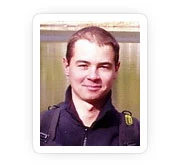Yoga Anatomy: How to Engage Your Tensor Fascia Lata for a Stronger Parsvakonasana

Many of the standing poses have a lunge component; that is, the forward hip and knee flex while the back hip and knee extend. It is not unusual in these types of asanas for the forward knee to drift inward, with the pelvis moving in the opposite direction. An example of this is Utthita Parsvakonasana (Extended Side Angle Pose).
Positioning the knee over the ankle aligns the leg bones, especially the femur and tibia. This brings the anatomic and mechanical axes closer together, so that support in the pose is derived more from the strength of the bones than from muscular effort. Additionally, allowing the knee to drift inward can place stress on the lateral compartment of the joint. Adjusting the position of the femur and the tibia aids to distribute the joint reaction forces over a greater surface area.

Here’s the Anatomy
The tensor fascia lata (TFL) originates from the front part of the outer surface of the iliac crest and the anterior superior iliac spine. It inserts onto the fascia lata (iliotibial band). The fascia lata continues down the thigh to insert onto the front outside of the upper tibia at Gerdy’s tubercle. The TFL abducts, flexes, and internally rotates the hip joint. It can also synergize the quadriceps to extend the knee when it is flexing less than 30 degrees. If the knee is flexing greater than 30 degrees, then the TFL can act as a knee flexor.


How to Engage Your Tensor Fascia Lata in Parsvakonasana
In my personal practice, I achieve this alignment by engaging the tensor fascia lata on the bent leg. To activate this muscle I straighten the elbow and then gently press the outside of the knee against the arm, as shown. This abducts the thigh at the hip joint. Because the arm keeps the knee from moving backward, the abduction component of the TFL has the biomechanical effect of drawing the pelvis forward. This helps to open the front of the body in the asana. Additionally, activating the tensor fascia lata synergizes the psoas in flexing the hip and tilting the pelvis. Tilting the pelvis forward in this manner laterally flexes the trunk and helps to turn the torso efficiently in the pose. The gluteus minimus, gluteus medius, and gluteus maximus muscles all contribute to these actions.
I follow up contracting the TFL with gently engaging the back-leg gluteus maximus to extend and externally rotate the hip. These combined movements aid to stabilize the pelvis and lengthen the adductor muscles.

Practicing with cues that engage muscle groups enhances the mind-body connection created by the pose. I use Tadasana (Mountain Pose) as a barometer to gauge this awakening by returning to it between the individual asanas.
Always, in your particular case, consult your healthcare provider before practicing yoga or any other exercise program. Always practice yoga under the direct supervision of a qualified instructor.
Want practice tips to protect your knees? Read Dr. Ray Long’s Yoga for Healthy Knees: Understanding Biomechanics Can Protect Your Knees in Lotus Pose.
Study knee health with YogaUOnline and Doug Keller – Yoga for Healthy Knees: Keys to Retaining Lifelong Mobility.
Reprinted with permission from Daily Bandha.
Illustrations by the Daily Bandha.
 Author Ray Long MD, FRCSC is a board-certified orthopedic surgeon and the founder of Bandha Yoga. Ray graduated from The University of Michigan Medical School with post-graduate training at Cornell University, McGill University, The University of Montreal and Florida Orthopedic Institute. He has studied hatha yoga for over twenty years, training extensively with B.K.S. Iyengar and other leading yoga masters.
Author Ray Long MD, FRCSC is a board-certified orthopedic surgeon and the founder of Bandha Yoga. Ray graduated from The University of Michigan Medical School with post-graduate training at Cornell University, McGill University, The University of Montreal and Florida Orthopedic Institute. He has studied hatha yoga for over twenty years, training extensively with B.K.S. Iyengar and other leading yoga masters.
 3d Graphic Designer / Illustrator Chris Macivor has been involved in the field of digital content creation for well over ten years. He is a graduate of Etobicoke School of the Arts, Sheridan College and Seneca College. Chris considers himself to be equally artistic and technical in nature. As such his work has spanned many genres from film and television to video games and underwater imagery.
3d Graphic Designer / Illustrator Chris Macivor has been involved in the field of digital content creation for well over ten years. He is a graduate of Etobicoke School of the Arts, Sheridan College and Seneca College. Chris considers himself to be equally artistic and technical in nature. As such his work has spanned many genres from film and television to video games and underwater imagery.


